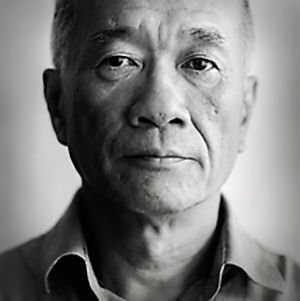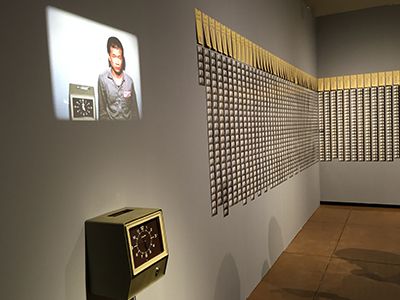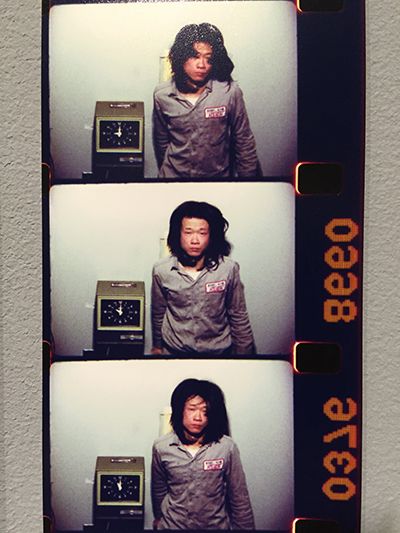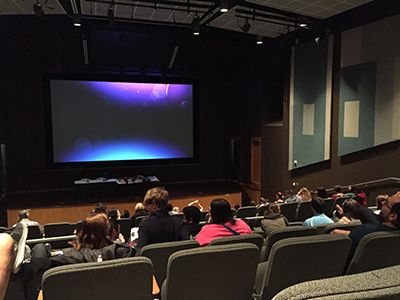Artist Lecture/Presentation Reviews
Throughout the 2015 Spring semester, we were asked to attend two artist lectures and two exhibitions/performances or film screenings. These are my critical summaries of all four of these events.
Clint Sleeper
Artist Lecture - February 26, 2015

Art has no bounds. At least that is what I felt when I attended my first artist lecture given by my ART 245 Digital Media I teacher, Clint Sleeper. Today he was giving a presentation on some of his prior works, which gave me an introduction to his unique creative insights and projects that I may not have known about otherwise.
The lecture was given in the William J. Raggio Building on the University of Nevada, Reno campus in a large lecture hall. The lecture had just started when I got there, and the spacious room had a number of attendees spatially distributed throughout.
In the audience, I recognized many familiar faces from the university's art department. I saw my photography teachers, like Emily Rogers and Meghan Burner. There were also a number of students there as well that I did not recognize but assumed were also art students.
The lecture was accompanied by a slideshow. The slideshow was simple in nature, no frills. Beneath the towering slides, moving through the shadows in the dimly lit room, was Clint, telling us about his work.
It started with his earlier works. As I found an empty spot in the back of the room, I heard Clint tell us about his days of musical exploration. Not just any musical exploration like you might find in a band or in mainstream music, but rather using something as bizarre as a Fisher-Price xylophone, electrically hooked up to other items, to create something my eyes and ears had never experienced before. This was a concept I was not familiar with, and it is difficult to explain (so here's a video) but I could tell he was passionate about it.
He also showed us an installation he created titled MIDI Televisions. This one stood out to me because it was beautiful in a way. Using recycled televisions, a Max MSP, and crowd-sourced midi compositions, Clint had set up an audio installation that caused the television screens to flicker with static when the sound activated. Some of the TV screens appeared linked, other times they seemed disjointed. The audio bloops would come and go, speed up and slow down, and ultimately I felt like this was the closest I could get to seeing sound. Very intriguing.
There were a number of other audio-based demonstrations that he showed us, but to write about the variation I saw during this lecture, I wanted to comment on the slides he showed us regarding making art in public places. If It's Still There When You Go Looking is the title of one of these pieces, which involves sneaking into places and installing makeshift swing-sets and brightly colored benches in places you wouldn't normally see them. This included setting up swings under billboards, and in shadier, urban parts of town. The materials for the benches and swings were reportedly pulled from construction sites around the city. It was clear to me that this project served a greater purpose. Clint provided an extended description regarding neoliberal policies, but I felt this was something I needed to learn more about in order to fully understand. In short, it was about reimagining city spaces, but I know that doesn't do the full project's intentions and message justice.
Overall, I really enjoyed the lecture. It gave me a chance to get to know my teacher better, which was important because, at first, I didn't know what to make of him. He's different than any other teacher I've had, which is a great thing and something that inspired me to come to class every day. I'm excited to see how his current and future works are received (like the What Class War project). It is great to have an instructor that doesn't just teach, but also practices as well.
Tehching Hsieh
Artist Lecture - April 16, 2015

For my second artist lecture, I watched a presentation given by Tehching Hsieh. Admittedly, I had never heard of Tehching before this semester, but I was immediately intrigued by his works once I was told about them.
To elaborate, Tehching is a performance artist. Not in the sense of a trapeze artist or street performer. Rather, Tehching is known for his extensive one-year performances that require extreme dedication and fortitude unlike anything I could imagine myself doing.
There was an amazing turnout in the Wells Fargo Auditorium. It was absolutely packed. Upon arriving, I was greeted by a mid-60s, unassuming Asian man standing behind the podium. He nodded as me as I sidestepped my way to an open seat in the crammed third row. Once again I saw many familiar faces from the art department. This was arguably the presentation of the semester, and I knew I'd kick myself if I hadn't been able to make it.
After a lengthy introduction by someone else from the art department, the man that had greeted me earlier revealed himself to be Tehching Hsieh. Controlling the computer on the podium, Tehching got straight into talking about five of his one-year performances.
The first piece he showed us is known as the cage piece. In 1978, Tehching decided that he would lock himself in a secluded, barred cell, like a prison cell, for one full year. He put up a slide of the rules he had given himself, which included not having radio or television, and that he could not leave the cell until the year was up. Like some of his other pieces, he had a camera set up to take a photo of himself once a day at a designated time. After 365 photos, the piece was over, and Tehching's work was done. Through broken English, Tehching told us about the experience and setup. He told us how he would sit in the corner of the cell as much as he could, which would make it so the space felt larger. I was speechless.
Tehching also told us about two other pieces; the rope piece and the outdoor piece. The rope piece involved tying himself to another artist for a full year (from 1983 to 1984) with an 8ft rope. During this performance, the artists had to be in the same room at all times and could not touch each other. That sounded annoying at best, but still something I could never imagine myself doing in the name of art. Tehching's outdoor piece was just as outrageous, which entailed him willingly exiling himself to the streets of New York City with nothing but a backpack and a sleeping bag for one full year. He showed us a video clip of him getting arrested, and the police trying to bring him into the police station. He screamed in horror, telling them that he can not go inside. They did not listen. He still went on to finish the performance.
The one-year performance that Tehching's art showing was mostly about was in regards to what he refers to as the time clock piece. This demonstration of unparalleled dedication required him to punch a time clock every hour, on the hour, for one year. Every time that he punched the clock, he would stand for a picture to be taken of him, which would later be crafted into a time-lapse movie to show his change over time. Like some of his other pieces, he shaved his head in the beginning, and let the hair grow out until the end to show the passage of time. If he was asleep, he would need to wake up every hour to punch the clock. This sounded like my worst idea of hell.
To wrap up the presentation, Tehching showed us a 3D model he had designed to demonstrate his full body of work. Each room represented a one-year performance. Space between the rooms demonstrated the time he took off between each performance. Together, it created a timeline of sorts. The idea is that people could walk through these rooms to get a sense of how long each performance took, and how much of Tehching's life was dedicated to his work. The largest room was the room on the end, which represented his 13 year plan. For the 13 year plan, Tehching said that he would make art during this time (1986 to 1999), but would not show it publicly.
Once the presentation was over, Tehching took questions from the audience. Some of the questions were lost in translation, but Tehching was very humble and enlightening in his responses. I had a question of my own, but we ran out of time fairly quick. We were then released to Tehching's art showing across campus.
To wrap up, I felt that Tehching Hsieh, and his lecture, were inspiring. His performances instantly struck me as something that few people would be capable of doing. It required such literal dedication to his craft that I couldn't help but to have immense respect for him. I loved his strategy to document each performance with the camera, and his commitment to finishing each performance. After hearing his speech, I was very excited to see the art showing, which I will write about next.
"Time Clock Piece"
Art Exhibition - April 16, 2015

Shortly after Tehching Hsieh finished his presentation, the group had migrated across campus to the art building. Here we would see photo stills and other items from Tehching's time clock piece.
When I arrived, the art department had an assortment of finger foods set up, including cookies and carrots. It was just as packed here as it was in the auditorium, if not more packed. People were everywhere, pressed shoulder to shoulder, and there was a line forming to get to what I thought was the art gallery, but was really for the bar – or maybe a combination of both.
I made my way past the line, and walked into the gallery. On the wall to our left was a number of framed documents, which included newspaper articles and the original rules that Tehching had written for himself for each performance.
As you walk in further, I was blown away by a beautiful display of still photos from the time clock piece. In a square room, all four walls were covered with perfectly-spaced photos, in columns, of Tehching standing next to the time clock. Each photo represented one hour. And each column represented one day in the year-long performance.
Above each column of photos was the timesheet for that day. You could see the exact time Tehching clocked in, and the times that he missed due to oversleeping. By looking at all of the photos next to each other, it was easy to see which photos were missing from when Tehching did not clock in. Overall, he had a very high success rate in clocking in as he had planned. I was very impressed.

Also in the room was a projector, which was showing the time lapse of all of the photos in a loop. You could see the gradual change in hair length from the start of the performance to the end, and you could easily see the performance taking its toll on Tehching. This was fascinating.
As I walked around the room, I glanced at each photo trying to figure out how he was feeling each day. Was he enjoying this project? In some photos I thought I saw a glimpse of regret, but maybe I am just projecting. The point is, Tehching made it to the end.
It was at this point that I saw Tehching standing in the room with me. I approached him, and we shook hands. I had two questions for him.
The first question I had was in regards perfection. I asked him about when he was arrested in New York City during his outdoor piece, and how they forced him to go inside. I asked him if that intervention made him want to stop the piece, abandon it, or to start over. For me, that interference by the police, and for them to show no regard for the rules of the art piece, would have been devastating – especially that far into completion. Tehching's answer was simple. He was not going for perfection, and that with his type of art, perfection is almost an impossibility. The idea is that for everything that was within his control, he stuck to the rules. Once he was released from the police station, he resumed his time outdoors. I admired his ability to let that go.
Next, I asked Tehching about ideas that he may have had, but never executed. I figured he had tons of time to think of other one-year performances while performing pieces like the cage piece and the outdoor piece, and I wondered which ones he decided to skip (if any) and why. It turns out that he did not really have any other performances in mind, and that the ones he did perform were the only ones he thought of. All very simple answers, and I am glad I had the opportunity to ask them and that Tehching was nice enough to answer them.
Overall, Tehching Hsieh's art showing was impressive, and really hammered home the idea of how much was involved in his one-year performances. After hearing about Tehching's story from others, and then hearing his explanation of each performance in his lecture, the final photos, timelapse, and time cards really put everything in perspective. I loved every bit of it.
"BDSM: It's Not What You Think"
Film Screening - May 8, 2015

As the semester's end snuck up on us, I had one more showing to attend. I decided to step out of my immediate comfort zone and see a film screening of a student production at the University of Nevada, Reno titled: "BDSM: It's Not What You Think."
While walking around campus, I saw flyers for this event. In sultry red and black colors, a woman holds a whip and challenges you with her eyes. It made me question: what really is BDSM? And what can I learn from this screening?
The event was held in the Joe Crowley Student Union Theatre on Friday, May 8th, 2015. I arrived on campus and made my way up through the first few floors of the Joe. Since it was late into the evening on a Friday, campus was pretty empty, but I did see some interesting people around the Joe that appeared to be involved with this event. I saw one girl wearing a makeshift "sexy" nurse outfit. I immediately felt like I didn't fit in.
The auditorium was about half full, mostly with students and a few older people. I saw that most people were there in couples, and I was there alone. This only made me feel more awkward.
After finding my seat, the house lights dimmed and the movie screening began. We were quickly greeted by a scene that appeared to be straight out of a low budget porn (no nudity). Just a woman spanking a man and telling him he had been naughty, no big deal.
The movie then progressed into a documentary of sorts. Based on what I had learned in my digital media class, I analyzed the animations and visuals the filmmakers had created to try to explain to us that BDSM is not just about sexual deviants, and that it certainly was not about rape and exploitation.
The film used a number of comedic cut-screens, sped up and filmed like an old western. The screen flickered like an old projector, and piano old-timey music played as the narrator explained that BDSM has roots that go back many years ago.
They then talked about the art of BDSM. Specifically about how BDSM is designed to make participants feel something, and that just like art (music, movies, etc.) it can be a healthy form of escape and entertainment. In fact, they tell us, that there is even an art school in San Francisco dedicated to coming up with new and creative ways to perform BDSM.
Further, they compared BDSM to the art of filmmaking. They call each act of BDSM a "scene," and that the participants get to be both the director and the actor for each scene. They talk about how participants will often meet before creating a scene to create a plan for their time together, and they explain it as though they are creating a screenplay.
Critiquing the film itself, they had good and consistent vocal audio quality. The cuts were coherent, and the composition for each scene was what you would expect for a documentary. The rule of thirds was heavily used, and most interviews were filmed with a one-camera setup.

The questions asked in the documentary were presented in text titles. They asked, "Isn't that Dangerous?" and "Does it Always Involve Sex?" Each question set the interviewees up to explain the common misconceptions about BDSM, and how it should not be so foreign and judged by others.
They then brought up BDSM and how it is currently portrayed in art today. They talked about poetry, and the rise of interest in BDSM through books (and subsequently the movie) Fifty Shades of Grey. This demonstrates that the mainstream is starting to take an interest in BDSM, but they are still getting a lot of it wrong.
As the screening came to an end, the credits were cut abruptly and the harsh house lights brightened. Everyone shielded their eyes as a tall lady in loud heals walked on the stage and introduced herself. She told us about the reason for making the film, and her involvement with UNR and the BDSM communities.
Her name is Michelle MacHardy. She is a graduate from UNR, graduating last year, and her area of study was psychology. She also tells us about how she has been a professional dominatrix for over 10 years, and how her and her partner run a business where clients could hire her to perform BDSM on them.
She showed us that she is currently up with the times, digitally. She has a modern looking website, which shows the various products used in BDSM (whips, handcuffs, etc.). I learned that they even have special candles just for BDSM-use that doesn't burn as hotly.
In the end, this movie screening was an interesting experience, and I am glad I went. I think that stepping out of one's comfort zone and going to a screening that you might not otherwise go to can help broaden your horizons and teach you something new. Now I know about this other, leather and latex filled world.